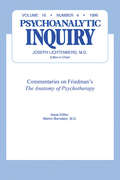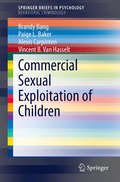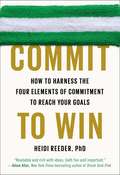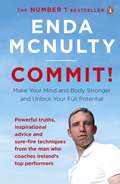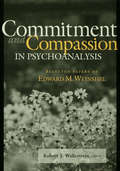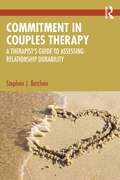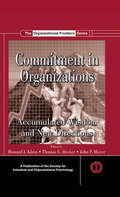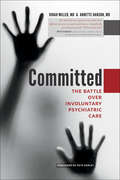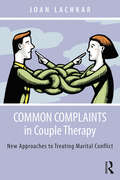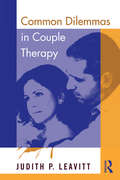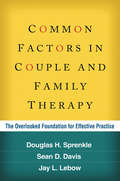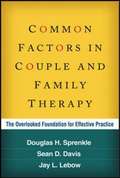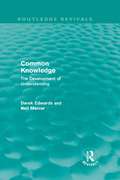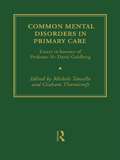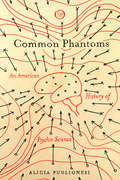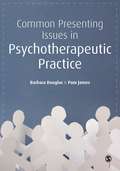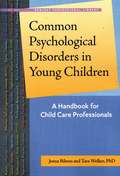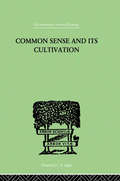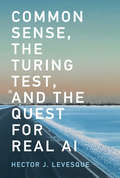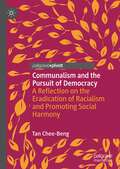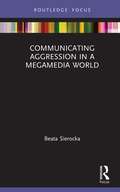- Table View
- List View
Commentaries: Psychoanalytic Inquiry, 16.4
by Melvin BornsteinFirst published in 1996. Routledge is an imprint of Taylor & Francis, an informa company.
Commercial Sexual Exploitation of Children (SpringerBriefs in Psychology)
by Brandy Bang Paige L. Baker Alexis Carpinteri Vincent B. Van HasseltThe commercial exploitation of children is a global crisis (Rahman, 2011; Svensson, 2006). However, media outlets and sociological researchers have successfully situated the problem as a primarily Asian, South American, or Eastern European concern. In the process, the exploitation of children in the United States has largely been ignored. The continued trafficking of international youth into this country, coupled with the growing rate at which American born children are targeted by interstate sex traffickers, speaks to the urgency with which the domestic exploitation of children must be addressed (Walker-Rodriguez & Hill, 2011). In fact, research suggests that an average of 250,000 American children and adolescents are at risk of commercial exploitation each year (Estes & Weiner, 2001). Further, there are indications that current data vastly underestimate the actual numbers of vulnerable and victimized youth (Chase & Statham, 2005). According to the U. S. Department of Justice (2007), no systematic efforts have been made to examine the commercial exploitation of children in this country. The low visibilities of the crime, combined with the inherent vulnerability of the victims, have facilitated the continued victimization of these children. The purpose of this book is to provide a critical analysis of the domestic, commercial exploitation of children. A careful explanation of the differing forms of commercial exploitation of children, victim and offender characteristics, and the mechanisms which maintain the problem will assist health care providers, researchers, and law enforcement in their efforts with this marginalized and understudied population. The authors begin with a comprehensive review of extant literature in this area. Additionally, case studies of child sexual exploitation are included to further illustrate the severity, complexity, and depravity of commercial exploitation in real life cases.
Commit to Win
by Heidi ReederWhat do you need besides motivation and willpower? In Commit to Win, Heidi Reeder, PhD, unpacks over forty years of research by psychologists and economists to show that the key to reaching any goal, whether it's to hit the gym more often or to finally quit that dead-end job, isn't motivation, willpower, or determination. It's commitment. Busting the myths most of us believe about commitment, Reeder shows that it all comes down to four variables: Treasures: the benefits we get from working toward a goal, Troubles: the difficulties we have to deal with, Contributions: the time, money, and effort we invest, and Choices: the number of good alternatives we have. Together, these variables make up a formula that not only measures how committed we are, but also shows which factors we can change to get our commitment level in sync with what we want to do. Packed with practical examples and action plans for a variety of situations, Commit to Win will allow readers to stop wishing for things to be different and instead make practical changes that will naturally empower them to reach their goals. It will appeal to readers of Succeed and The Willpower Instinct.
Commit!: Make Your Mind and Body Stronger and Unlock Your Full Potential
by Enda McNulty'An onslaught of positivity from start to finish . . . Plenty [of people] will find something in it to help them along' Irish TimesAs an All-Ireland winning footballer and a successful motivational coach and businessman, Enda McNulty has an intimate knowledge of what it takes to achieve real success.Enda has worked with international high achievers such as rugby legend Brian O'Driscoll, the Leinster and Irish rugby teams, Olympian David Gillick, Riverdance principal dancer, Padraic Moyles, and top management teams in companies like Digicel, Diageo, Intel, Microsoft and Facebook. He knows how to help people reach their potential.Enda believes that our greatest fulfilment comes from finding, and working to achieve, our life's true purpose. In Commit! he explains how to go about doing this.Drawing on his personal and professional experience, Enda demonstrates how to harness your strengths so you can live a more purposeful life.He explains how to develop a mindset that will help you to recognise and embrace opportunity.He explores resilience and mental toughness and how to develop both.And he provides practical guidance on managing physical wellness through the right mix of exercise and nutrition.Using examples from the wide variety of the people Enda has helped - some well-known, some not so well-known - Commit! blends real world experience with the wealth of personal insight and expertise Enda has built up over the years.It is nothing less than a one-stop manual for becoming the truest most fulfilled version of yourself you can be.'After working with Enda and his team my onstage performances improved significantly and the work still helps me reach my potential in every facet of life' Padraic Moyles, lead dancer, Riverdance'Working with Enda McNulty made a positive difference to how I do my job. I have a renewed sense of purpose, clarity and perspective' Eamonn Sinnott, General Manager, Intel Ireland'Enda's understanding and skill were crucial in helping me to reach my potential as an athlete. And I still use the tools he gave me in my post-athletic career' David Gillick, Olympian'Enda McNulty has an intimate knowledge of what it takes to achieve real success' Sunday World
Commitment and Compassion in Psychoanalysis: Selected Papers of Edward M. Weinshel
by Robert S. WallersteinOver the course of his distinguished career, Edward Weinshel has been a moral and intellectual force in contemporary psychoanalysis and an outspoken opponent of current trends in and out of the field toward dehumanization and deindividualization. Commitment and Compassion in Psychoanalysis, under the editorship of Robert Wallerstein, brings together 14 of Weinshel's major papers. The six clinical papers reprinted in this collection address the kaleidoscope of common personality organizations and propensities which, in their extreme variants, motivate individuals to seek psychoanalytic assistance, covering topics that include "neurotic equivalents" of necrophilia, negation, lying, "gaslighting" (brainwashing), perceptual distortion during analysis, and inconsolability. These clinical expositions are supplemented by eight theoretical papers in which Weinshel gives expression to the metapsychological paradigm of ego pyschology as it existed in the 70s and 80s. Four of the papers from the early 70s cover "the ego in health and normality," the transference neurosis, and various aspects of the training analysis. The remaining four papers, published between 1984 and 1992, chronicle Weinshel's notion of resistence as the clinical unit of the psychoanalytic process, his elucidation of specifically "psychoanalytic change" as it grows out of the psychoanalytic process, and his affirmation of modern conflict theory in the face of theoretical pluralism. Carefully edited by Robert Wallerstein and including an introductory essay by Leonard Shengold, Commitment and Compassion in Psychoanalysis brings to contemporary debates the voice of a principled exemplar of the psychoanalytic calling. Balancing intellectual acuity with a profoundly caring temperament, and augmenting respect for the psychoanalytic tradition with a flair for original ideas, Edward Weinshel speaks to all who wrestle daily with the burdens, challenges, and healing promise of the impossible profession.
Commitment in Couples Therapy: A Therapist’s Guide to Assessing Relationship Durability
by Stephen J. BetchenCommitment in Couples Therapy offers a comprehensive clinical guide to help those who work with couples determine the authenticity of a couple’s commitment, and to guide their decision on whether the relationship is worth salvaging.The purpose of this book is to focus on those couples who have joined for reasons that pose a significant chance of relational failure. This specific dyad entails one seemingly “committed” partner and one apparently “less committed” partner, both of whom may be conscious or unconscious about their sabotaging behavior in the relationship. Betchen offers a clinical model to treat the commitment issue and help the couple’s therapist skillfully uncover each partner’s conflict with commitment, determine the couple’s true relational status, and determine how to re-contract the relationship on more authentic grounds. Chapters provide coverage of the unconscious match process, the sociocultural, transactional, familial, and psychological factors behind commitment, and countertransference, with case studies throughout. Finally, this book offers critical assessment and treatment strategies for therapists to implement in their practice.This book is an essential read for mental health clinicians of all levels, and a valuable resource for graduate students in marriage and family therapy programs.
Commitment in Organizations: Accumulated Wisdom and New Directions (SIOP Organizational Frontiers Series)
by New Directions Accumulated WisdomCommitment is one of the most researched concepts in organizational behavior. This edited book in the SIOP Organizational Frontiers series, with contributions from many scholars, attempts to summarize current research and suggests new directions for studies on commitment in organizations. Commitment is linked to other concepts ie. satisfaction, involvement, motivation, and identification and is studied across cultural lines. Both the individual and group levels of building and maintaining commitment are discussed.
Committed: The Battle over Involuntary Psychiatric Care
by Dinah Miller Annette HansonA compelling look at involuntary psychiatric care and psychiatry’s role in preventing violence.Battle lines have been drawn over involuntary treatment. On one side are those who oppose involuntary psychiatric treatments under any condition. Activists who take up this cause often don’t acknowledge that psychiatric symptoms can render people dangerous to themselves or others, regardless of their civil rights. On the other side are groups pushing for increased use of involuntary treatment. These proponents are quick to point out that people with psychiatric illnesses often don’t recognize that they are ill, which (from their perspective) makes the discussion of civil rights moot. They may gloss over the sometimes dangerous side effects of psychiatric medications, and they often don’t admit that patients, even after their symptoms have abated, are sometimes unhappy that treatment was inflicted upon them.In Committed, psychiatrists Dinah Miller and Annette Hanson offer a thought-provoking and engaging account of the controversy surrounding involuntary psychiatric care in the United States. They bring the issue to life with first-hand accounts from patients, clinicians, advocates, and opponents. Looking at practices such as seclusion and restraint, involuntary medication, and involuntary electroconvulsive therapy—all within the context of civil rights—Miller and Hanson illuminate the personal consequences of these controversial practices through voices of people who have been helped by the treatment they had as well as those who have been traumatized by it.The authors explore the question of whether involuntary treatment has a role in preventing violence, suicide, and mass murder. They delve into the controversial use of court-ordered outpatient treatment at its best and at its worst. Finally, they examine innovative solutions—mental health court, crisis intervention training, and pretrial diversion—that are intended to expand access to care while diverting people who have serious mental illness out of the cycle of repeated hospitalization and incarceration. They also assess what psychiatry knows about the prediction of violence and the limitations of laws designed to protect the public.
Common Complaints in Couple Therapy: New Approaches to Treating Marital Conflict
by Joan LachkarMarriage and couple therapists see clients with broken relationships and bonds all the time; those who were once madly in love can grow indifferent, people change, and couples go into sessions feeling depressed, traumatized, and sometimes abused by their partners. Joan Lachkar examines the vicissitudes of love relations by taking into account aspects of aggression, cruelty, sadism, envy, and other primitive defenses lurking in the shadows of love and intimacy. Each chapter revolves around a specific situational conflict, with guidelines and treatment suggestions offered to the therapist. Numerous vignettes and detailed descriptions of theoretical technique, methodology, and diagnostic distinctions are included throughout the book to help readers see theory in action. The theoretical concepts drawn on include psychoanalysis, object relations, self-psychology, attachment theory, DBT, mindfulness, and others, with a heavy emphasis on listening and non-verbal and verbal communication throughout.
Common Dilemmas in Couple Therapy
by Judith P. LeavittCommon Dilemmas in Couple Therapy addresses four common problems that couples therapists face everyday in their offices – problems that leave therapists exhausted, drained, challenged, alive, racing, and on edge. These dilemmas encompass not only the difficult challenges therapists face everyday, but also the passions and profound disappointments of human intimate partnerships. The purpose of this book is not only to explore and give case illustrations of these dilemmas, but also to give therapists strategies to use and help them understand and handle their own profound experiences while doing this work.
Common Factors in Couple and Family Therapy
by Sean Davis Douglas SprenkleGrounded in theory, research, and extensive clinical experience, this pragmatic book addresses critical questions of how change occurs in couple and family therapy and how to help clients achieve better results. The authors show that regardless of a clinician's orientation or favored techniques, there are particular therapist attributes, relationship variables, and other factors that make therapy specifically, therapy with couples and families effective. The book explains these common factors in depth and provides hands-on guidance for capitalizing on them in clinical practice and training. User-friendly features include numerous case examples and a reproducible common factors checklist.
Common Factors in Couple and Family Therapy: The Overlooked Foundation for Effective Practice
by Douglas H. Sprenkle Sean D. Davis Jay L. LebowThe major strength of this book is that it is the first of its kind in marriage and family therapy. It does a very good job of summarizing all of the existing literature (e. g. , journal articles and psychotherapy books), so if you haven't read much on common factors, this will be a great book for you. If you have a solid understanding of common factors, this can still be a very good book, but I wouldn't expect anything new or groundbreaking. The authors acknowledge that a great deal more research is needed to truly understand common factors, but they do a good job of presenting the information that currently exists. Some of the information you will gain from this book is (1) an understanding of how common factors influence relational therapy; (2) the history of common factors in other fields; (3) a few specific common factors that have been studied more than others (e. g. , therapeutic alliance, client motivation); and (4) how a common factors approach/framework can influence clinical work with couples and families.
Common Knowledge: The Development of Understanding in the Classroom (Routledge Revivals)
by Neil Mercer Derek EdwardsFirst published in 1987, Common Knowledge offers a radical departure from the traditionally individualistic psychologies which have underpinned modern approaches to educational theory and practice. The authors present a study of education as the creation of ‘common knowledge’ or shared understanding between teacher and pupils. They show the presenting, receiving, sharing, controlling, negotiating, understanding and misunderstanding of knowledge in the classroom to be an intrinsically social communicative process which can be revealed only through close analysis of joint activity and classroom talk. Basing this analysis on a detailed examination of video-recorded school lessons with groups of 8 to 10-year-olds, they show how classroom communications take place against a background of implicit under-standing, some of which is never made explicit to pupils, while there develops during the lessons a context of assumed common knowledge about what has been said, done, or understood. This wide-ranging study makes an important contribution to the current debate about both teaching methods and the structure of education. It is essential reading for educationalists and developmental psychologists and has a clear practical relevance to teachers and teacher trainers.
Common Mental Disorders in Primary Care: Essays in Honour of Professor David Goldberg
by Graham Thornicroft Michele TansellaCommon Mental Disorders in Primary Care provides a thorough overview of the diagnosis, treatment and management of the most common mental disorders encountered in primary care. In this book, published to mark the retirement of Professor Sir David Goldberg, distinguished contributors bring together clinical and research work drawn from psychiatry, medicine, psychology, social work and sociology, covering such topics as:* the biological basis of common mental disorders* disability and depression in primary care* the limits of mental health care in general medical clinics* improving the management of mental disorders in the elderly* training the whole primary care team.Common Mental Disorders in Primary Care provides an authoritative review of the subject for professionals working in the area of primary care.
Common Phantoms: An American History of Psychic Science (Spiritual Phenomena)
by Alicia PuglionesiSéances, clairvoyance, and telepathy captivated public imagination in the United States from the 1850s well into the twentieth century. Though skeptics dismissed these experiences as delusions, a new kind of investigator emerged to seek the science behind such phenomena. With new technologies like the telegraph collapsing the boundaries of time and space, an explanation seemed within reach. As Americans took up psychical experiments in their homes, the boundaries of the mind began to waver. Common Phantoms brings these experiments back to life while modeling a new approach to the history of psychology and the mind sciences. Drawing on previously untapped archives of participant-reported data, Alicia Puglionesi recounts how an eclectic group of investigators tried to capture the most elusive dimensions of human consciousness. A vast though flawed experiment in democratic science, psychical research gave participants valuable tools with which to study their experiences on their own terms. Academic psychology would ultimately disown this effort as both a scientific failure and a remnant of magical thinking, but its challenge to the limits of science, the mind, and the soul still reverberates today.
Common Presenting Issues in Psychotherapeutic Practice
by Barbara Douglas Pam JamesLearning how to work effectively with a broad range of clients and their presenting issues is a vital part of a career as a therapist, but engaging with the often conflicting worlds of descriptive psychopathology and the subjective meanings of the therapist and client is a real challenge for trainees. They have to develop the skills and knowledge that allow both approaches - one medical, one humanistic - to work successfully together. With the support of expert contributors, Pam James and Barbara Douglas help your students to confidently do just that, proving a comprehensive introduction to the theory, research and practice behind a range of common presenting issues. Key issues covered include: - Anxiety - Depression - Trauma - Bipolar disorder - Psychosis - Eating disorders - Borderline personality disorder This book should be on the desk of every counselling, psychotherapy and counselling psychology trainee, and is recommended reading for other practitioners of health and social care working with these common presenting issues.
Common Psychological Disorders in Young Children: A Handbook for Early Childhood Professionals
by Jenna Bilmes Tara WelkerCommon Psychological Disorders in Young Children brings together in one handy reference book the most common psychological disorders—such as ADHD, autism, and -anxiety—that childcare providers encounter. Information on symptoms, behaviors, medi-cations, classroom management, and parent communication is included.
Common Sense And Its Cultivation (International Library Of Psychology Ser. #Vol. 40)
by Hankin, E HanburyFirst published in 1999. Routledge is an imprint of Taylor & Francis, an informa company.
Common Sense, the Turing Test, and the Quest for Real AI
by Hector J. LevesqueWhat artificial intelligence can tell us about the mind and intelligent behavior. What can artificial intelligence teach us about the mind? If AI's underlying concept is that thinking is a computational process, then how can computation illuminate thinking? It's a timely question. AI is all the rage, and the buzziest AI buzz surrounds adaptive machine learning: computer systems that learn intelligent behavior from massive amounts of data. This is what powers a driverless car, for example. In this book, Hector Levesque shifts the conversation to “good old fashioned artificial intelligence,” which is based not on heaps of data but on understanding commonsense intelligence. This kind of artificial intelligence is equipped to handle situations that depart from previous patterns—as we do in real life, when, for example, we encounter a washed-out bridge or when the barista informs us there's no more soy milk. Levesque considers the role of language in learning. He argues that a computer program that passes the famous Turing Test could be a mindless zombie, and he proposes another way to test for intelligence—the Winograd Schema Test, developed by Levesque and his colleagues. “If our goal is to understand intelligent behavior, we had better understand the difference between making it and faking it,” he observes. He identifies a possible mechanism behind common sense and the capacity to call on background knowledge: the ability to represent objects of thought symbolically. As AI migrates more and more into everyday life, we should worry if systems without common sense are making decisions where common sense is needed.
Common Threads: Nine Widows' Journeys Through Love, Loss, and Healing
by Diane S KaimannThe middle-aged women described within the chapters of "Common Threads" are ordinary yet extraordinary. They have faced one of life's greatest challenges, working day-in and day-out to design new lives for themselves. As readers witness the resilience of the human spirit, they come to a new perspective on their own experiences, recognizing the good still in their lives. "Common Threads" is a tender and warm embrace, a story of faith and love, of insight, determination, independence and strength. These women's large and small victories are metaphors for hope and continuity.
Commonsense Psychology and the Home (Psychology Revivals)
by Frederick H. DoddFirst published in 1933, Commonsense Psychology and the Home was a book for parents and others who were interested in the welfare of the child and who, although sceptical of, and confused by, the conflicting schools of modern psychology at the time, desired guidance from modern knowledge combined with experience which they could appreciate as appealing to their common sense. It deals with the ideals of home life, from the choice of the partner to make a home, through the whole development of the family, ending up on the arrival of grandchildren. It shows the commonsense application of psychological principles to the happy and harmonious development of the home and the ultimate achievement of a freed personality when the child goes out into the world. It shows, step by step, how major difficulties may be avoided and minor difficulties handled.This book is a re-issue originally published in 1933. The language used and views portrayed are a reflection of its era and no offence is meant by the Publishers to any reader by this re-publication.
Communal Functions of Social Comparison
by Zlatan Križan Frederick X. GibbonsThe extent to which we see ourselves as similar or different from others in our lives plays a key role in getting along and participating in social life. This volume identifies research relevant to such communal functions of social comparisons and summarizes and organizes this research within a single, coherent conceptual framework. The volume provides an important addition to current thinking about social comparison, which has often neglected communal and affiliative functions. Whereas human desire to compare with others has traditionally been viewed as motivated by self-centered needs such as self-evaluation, self-enhancement, and self-improvement, this book presents an eclectic cross-section of research that illuminates connective, cooperative, and participatory functions of social comparisons. In this vein, the book aims both to expose research on currently neglected functions of social comparisons and to motivate a broader theoretical integration of social comparison processes.
Communalism and the Pursuit of Democracy: A Reflection on the Eradication of Racialism and Promoting Social Harmony
by Chee-Beng TanThis Palgrave Pivot examines why racialism is so persistent and the challenges it poses to the functioning of democracy and the attainment of national integration. It introduces an evolutionary psychology framework, which explains human innate potential to identify with and defend one’s group, but argues that racial dislike and conflicts are provoked by racial ideologies and the politics of ethnicity. By comparing the politics of race in a number of countries, including Malaysia and the United States, this book argues that attachment to one’s ethnic and religious identities does not hinder ethnic harmony. It is necessary to manage the issues of race and religion as well as promoting conviviality and cosmopolitanism for pursuing the ideal of common humanity and for maintaining a stable and meaningful democracy. This book concludes that democracy, as practiced, has some major weaknesses; as an ideal, it is still the best form of government to pursue.
Communicating Affection
by Kory FloydExplores how and why people express affection, the many positive effects it can have, and the risks it often carries.
Communicating Aggression in a Megamedia World (Routledge Focus on Communication Studies)
by Beata SierockaThis book describes how, in the era of megamedia culture, aggression in communication constitutes a threat to the communication community. Based on the theoretical incorporation of transcendental pragmatics, the book explores how conceptualizing the phenomena of megamedia aggression from this perspective and diagnosing their destructive force are essential for: postulating the need for constructing a theory of media communication closely related to the model of discursive rationality, giving this theory a critical and normative character, and embedding it in the perspective of the project of social co-responsibility and in the plan for an ethics of co-responsibility. Combining key elements of media theory, the philosophy of communication, the concept of normative ethics and the fields of social psychology and social anthropology, this book will be of great interest to scholars and students in the areas of communication studies, philosophy, anthropology, psychology and psychoanalysis.
